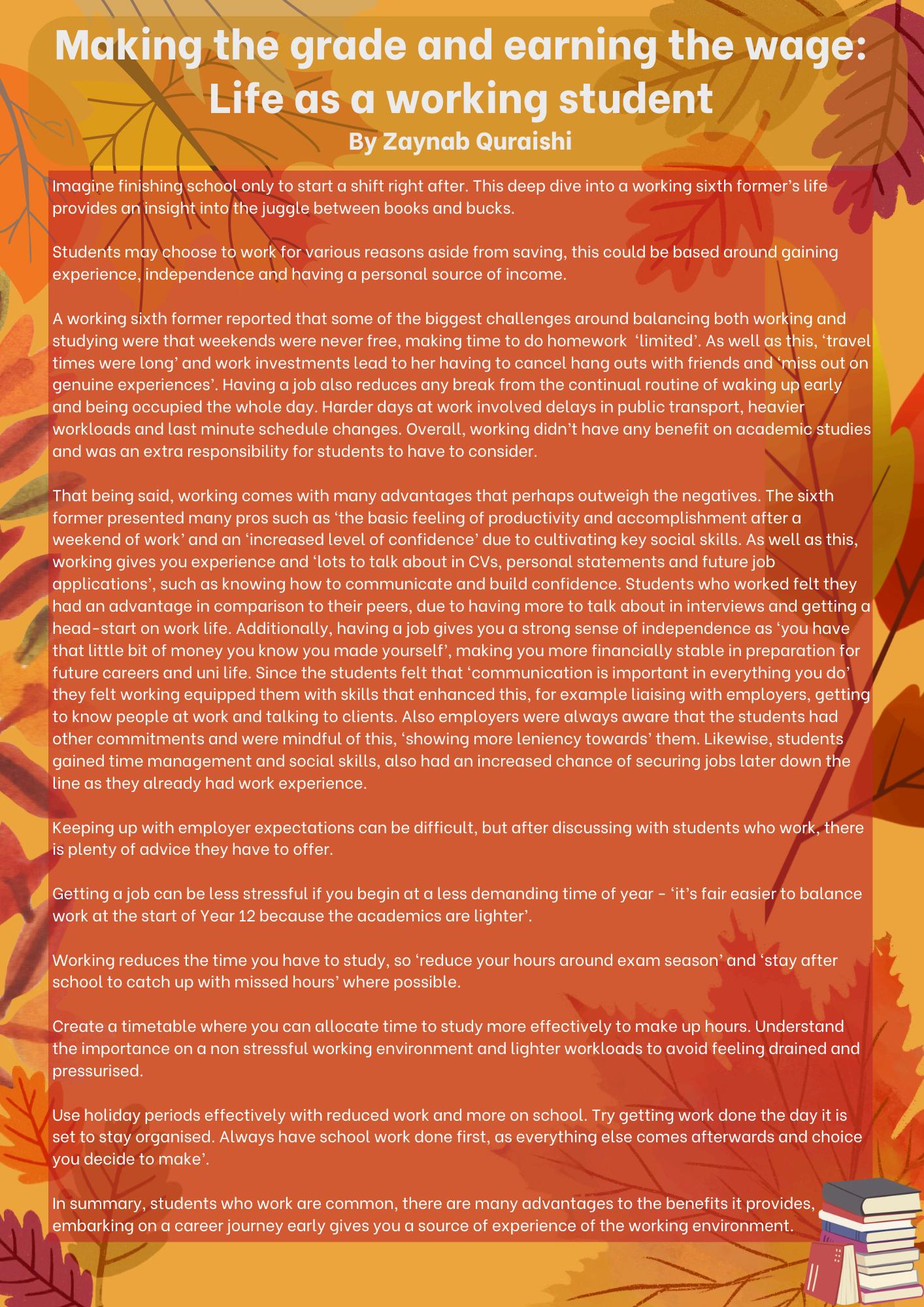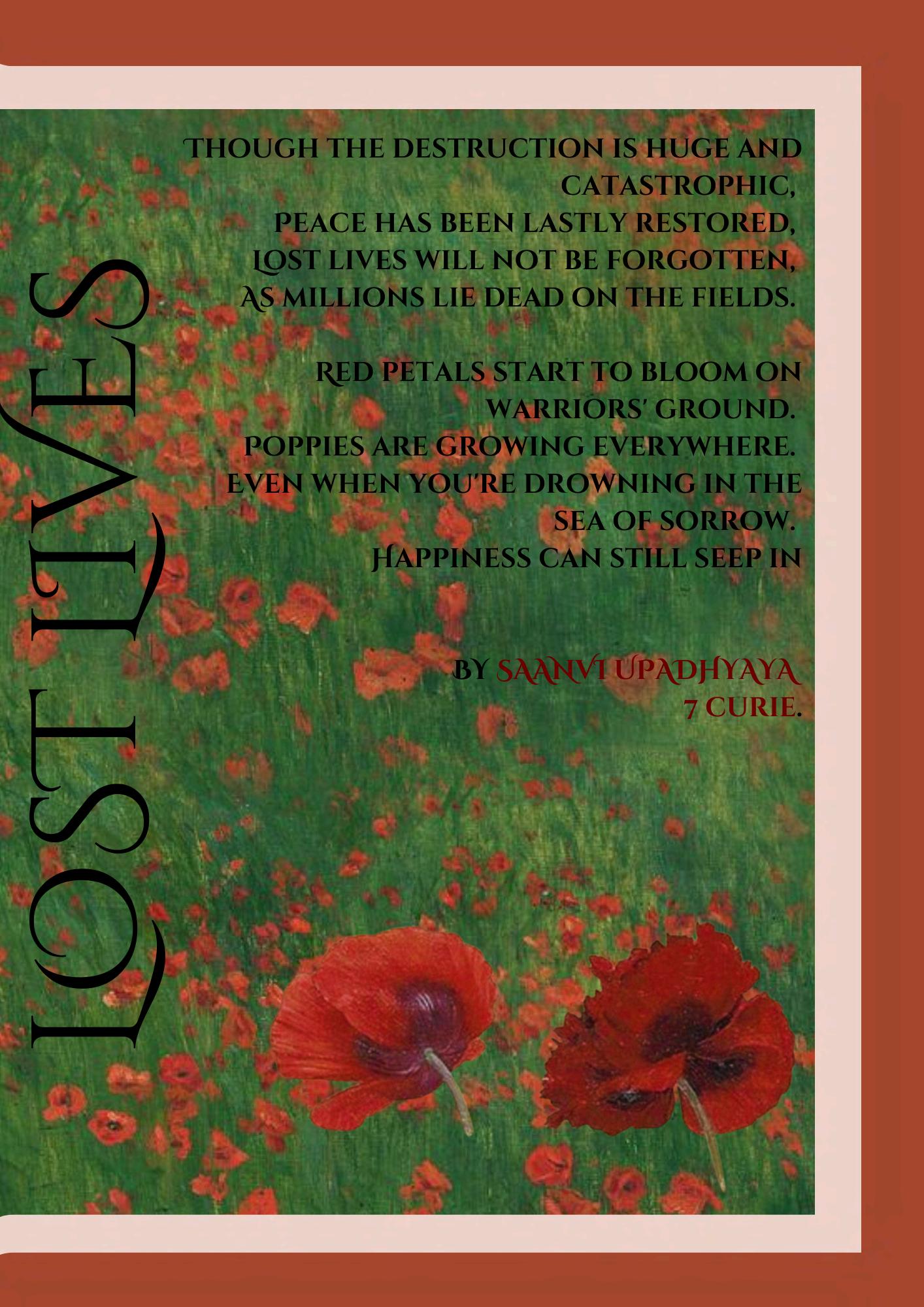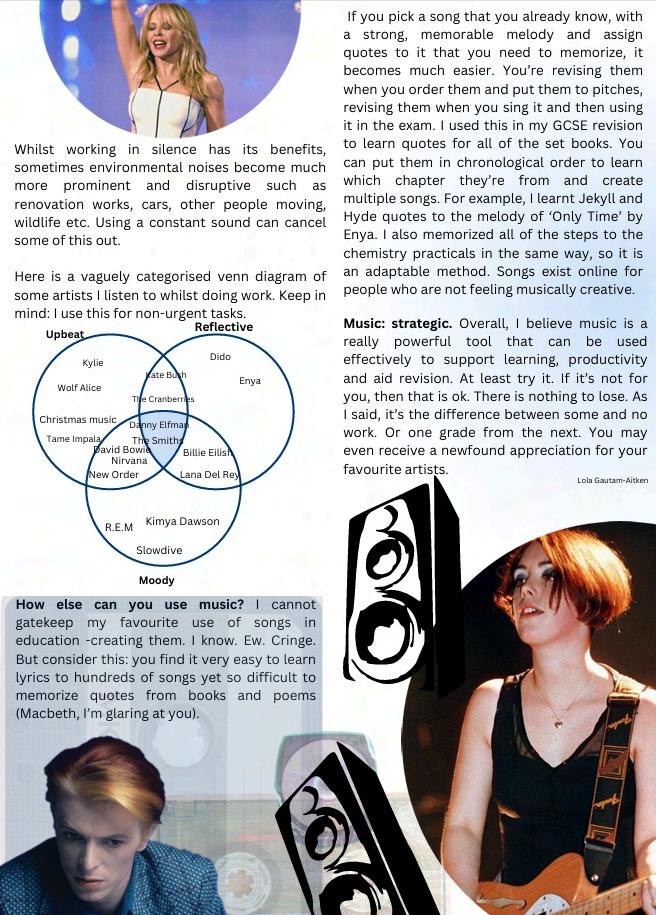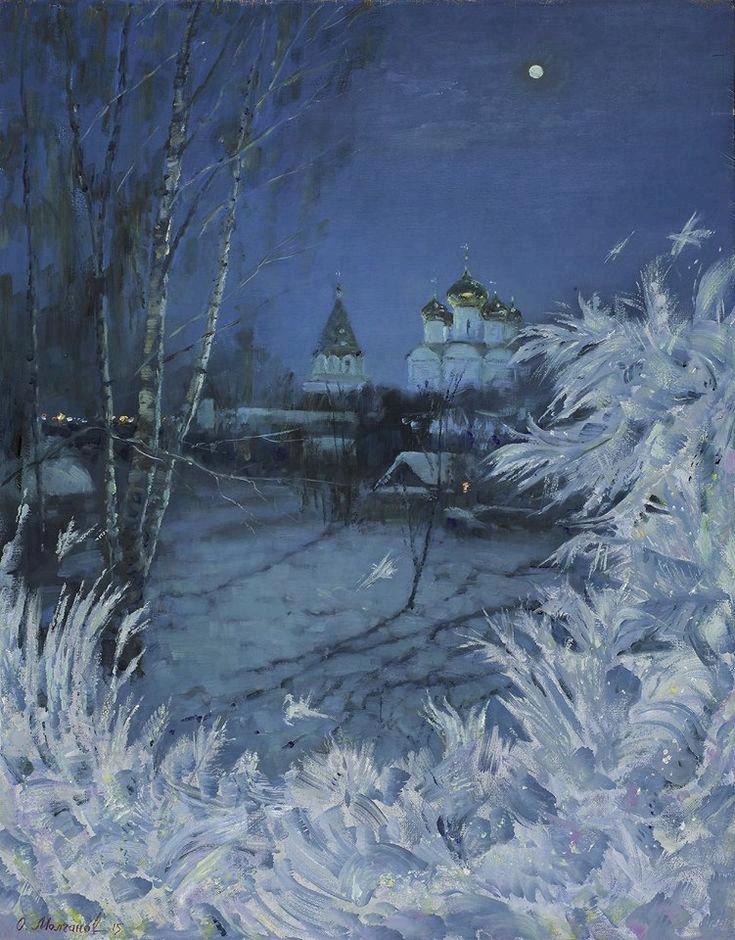

WALLY WALLY WALLY STREET STREET STREET
JOURNAL JOURNAL JOURNAL







Princess Kwade

‘ForzaFerrari!’
- an homage to Formula 1, along with the tidal change (and chaos) it brings


Screams of joy and jubilation alike ring out resoundinglythroughthecrowdpresent,asthefirst and only Brazilian Grand Prix of 2024, which has always been in São Paulo, finally comes to an end— marking a return to form for the Dutchman, Max Verstappen,asheclaimed1st,alongwiththeAlpine drivers, Esteban Ocon and Pierre Gasly, claiming 2ndand3rdrespectively;afeatthat’scertainlyone of the highlights of the weekend, considering that Alpine have always been a midfield team, usually placingfromaround8thto15thinracesdepending onthecircuit.
However, to anybody with a surface interest in Formula 1, or even for a casual fan who doesn’t watch the qualifying races for each Grand Prix (a decision that I can’t fault, since some qualifiers can be perceived as underwhelming and mundane, when taking the wider picture of the sport into context), Brazil has been anything but underwhelming and mundane, let alone boring, from the get-go—some statistics would certainly help,no?
Let’s start off simple, since it’s been a dramatic weekend,toputitlightly:freepractice1,thesprint qualifying and the actual sprint all went well, but with the heavy rain on Saturday afternoon, the actual qualifying race (to decide the lineup for the Grand Prix) was pushed to Sunday morning for the sake of everyone’s safety by the FIA—but things wentdownhillfromhere, rapidly.
-Muskaan Khaidun, Year 12


Now here’s where things begin to become more confusing, so bear with me for a little longer before I gettothedramathatyou’reallwaitingtohearabout!
The qualifying for each race is split into 3 ‘quarters’— Q1, Q2 and Q3—with each ‘quarter’ lasting for varying amounts of time depending on weather conditions, driver collisions and other factors; in Q1, the drivers who place from 16th to 20th are all eliminated, while in Q2, the drivers from 11th to 15th are subsequently eliminated, and in Q3 the remaining 10 drivers compete to be in pole position (1st place) for the GrandPrix.
You wouldn’t expect a lot of drama to ensue during these, would you? Maybe a few collisions and some swearingovertheteamradioshereandthere,butthe events that unfolded during the São Paulo qualifying verged on record-breaking, quite literally—with 5 red flags caused by Colapinto crashing into the barriers during Q1, Sainz crashing in the same area as ColapintoduringQ2,Strollcrashing—youcanguess,in thesameareaagain—attheendofQ2,Alonsocrashing due to the water still on the track, and then Albon crashing towards the end of Q3, due to his car aquaplaning. Thankfully, nobody was injured during any of these crashes, but with only 4 hours between the qualifying and the actual Grand Prix, Albon unfortunatelyhadtopulloutoftheGrandPrixrace,as the Williams mechanics simply didn’t have time to repairbothFranco’scarandhiscartoo(astherearof Albon’scarwasfullydestroyedduringhiscrash).
Anddon’tevengetme started onthechaosthatwas the Grand Prix: the first black flag (which is an automaticdisqualificationforaseriousbreachofthe rules) was shown in 17 years—not since the 2007 Canadian GP—5 drivers DNF’d due to crashes and similar issues—and that’s before mentioning how they had to repeat the formation/first lap 3 times, because multiple drivers were investigated by the FIA for ‘leading the field away for another lap even though no green light indicated that they could do so’,resultinginNorris(thepolesitterfortheGP)and Russellbeingfined,withMercedesadditionallybeing fined 10,000 euros for tyre pressure issues with theircars!
But enough of me recounting São Paulo—this wouldn’t be an homage to the sport if we didn’t reflect on the main drivers on the grid at the moment!
Forastart,LewisHamiltonisknownformanythings, and one of his virtues is that he promotes all things humanitarian, from being a vegan to advocating againstracisminsport,andFormula1especially,and also publicly supporting and encouraging youth that are aspiring to become drivers in the future—we can all take a lesson or two from the seven time world champion,that’sforcertain.

Max Verstappen is more interesting, in the sense that he’s a tough nut to crack in terms of his true personality off the track—mostly notorious for his extremely talented driving skills and explicit language that constantly causes him to become the target of FIA stewards, his rise both in the rankings and the Formula world has marked him as one to watch, if him being a three time world champion doesn’t say enough.
AndasaFerrarifan(orTifosi,asthey’recalledintheir home country Italy), I'd be amiss not to mention that Ferrari are being marked as being likely to overtake McLaren in the WCC and claim the Constructors’ Championship of 2024, even if Verstappen wins the Drivers’ Championship—a prospect that nobody over atFerrariisupsetabout,that’sforsure.
Despite the fact that Ferrari stumbled at the start of this year, struggling to find their footing whilst, Verstappen claimed race win after race win, it seems thatCarlosSainz’emergencyappendectomymarkeda turning over of a new leaf for the team; Sainz went on to win at Australia, while Leclerc—his teammate—won at both Monaco and Monza (with the latter being notable, as it’s the home of the Tifosi), and the latter wentontoalsoleadaFerrari1-2withSainzatCOTA(a 1-2 is essentially where both drivers in a team claim first and second place in a race, respectively), setting theteamupforanotherhightheweekafter,withSainz claiming his 4th career win in Mexico, with Leclerc scoringapodiumfinishin3rd.
Fromonefanto(hopefully)another, Here’stoenjoyingthelast3racesofthe2024season, and most likely seeing Max winning his 4th consecutivechampionship!






AUTUMN BEAUTY
Slowly retreating back into her shell. Autumn introduces herself with a splash of colour, Summer has no time to dwell.
The deciduous trees with their flamboyant foliage, Browns, oranges, yellows and breathtaking golds, A dazzling display of crimson leaves, A whole new world slowly unfolds.
The sound of leaves crunching beneath my feet, I never want to let it go, The world is my haven, The sun shining down with its rosy glow.
Each tree is a wonder, With beauty untold.
Each leaf brushed with varying hues, A majestic sight to behold!
Autumn prances boldly, With her bright auburn hair, Dances with the trees, Leaving them cold and bare.
People might love the autumn, For reasons like the leaves, like the sights, But why do I love it, you ask? I just adore the pumpkin pie!



The Psychology of Conformity: Why do we follow the crowd?
By Veronika Bavdyk
You are product of your environment. Whether you like it or not; it is a fact you must accept. No matter how hard you try, you will conform.
Let me clarify, I do not mean you will turn into a conformist zombie, a yes man to everyone and everything, but you will, and already have, experienced conformity on unprecedented levels.
We learn about the dangers of peer pressure with drugs and alcohol as soon as we are starting to encounter it and are cognitively developed enough to understand it. “Don’t do it just because your friends are doing it,” and “you can say no,” but to what extent can we say no? How do we, as a social race who base our identity on being part of a group, go against the social gradient and say no?
Jenness (1932) conducted a study where people would estimate how many beans were in a jar. After their initial estimate, they discussed their answers with each other.

Nearly all 101 participants changed their answer, conforming to the answers of their peers. When I participated in this experiment in Psychology class, I too conformed; I became a sheep to the opinions of my class. However, having changed my answer, I ended up guessing the number of beans correctly and enjoying a nice little mars bar from Ms Whitely-Beckford! So perhaps, being a conformist zombie isn’t a bad thing!
Consider this, you are walking in Central London, everyone around you looks up, would it be wrong for you to look up too? Well clearly… no, you are avoiding the possibility of a falling threat.
You’re in an elevator and you turn to face the same way everyone else is. Have you lost your sense of identity as an individual because you have done so? No. You have simply avoided embarrassment. But what if, you are presented with an obviously wrong answer? What if everyone suddenly starts saying 2+2=5? How long would it take you start saying that too? And how long for you to start believing it?
Solomon Asch, known as the founding father of conformity psychology, set out to investigate this very question with his famous Classical Line study in 1951. The study consisted of actors (whom he called confederates) and a real participant. They were asked to compare which line matches in length to which, like the figure below:


After the confederates all said the incorrect answer (for example b in the figure above) the true participant would say their answer. Would you expect them to say the right answer or to conform? After all, this situation is clear and unambiguous in terms of the answer (c in the figure above), surely, they would see the correct matching line and proclaim this answer. What Asch found is that even amid an incorrect crowd, 75% of real participants conformed at least once. Yes… 75 percent.
His findings were quite revolutionary and changed the way psychologists thought about human behaviour.
Many have argued that the findings of his study are outdated, therefore lacking in temporal validity, as the study was conducted in 1951. However, even modern-day replications have found very similar results. This begs the question: is conformity in our very nature? The evidence seems to point to the answer being yes.

But what are the limits of conformity? We probably won’t end up a zombified society… right? Well with the way the people are living now, we may be getting dangerously close to this.
Think about how different such mundane aspects of life are now compared to 50 years ago when phones didn’t exist. Social media is the ultimate catalyst of conformity. 80% of parents allow 3–5-year-olds to use their phone as an effective means to calm them down. Whatever happened to comfort? Connection?
Society has lost the concept of human uniqueness, and the more media we consume, the more this shapes our own ideas, we start to identify with the trends, and stop identifying with ourselves. We conform to the latest fashion trends, music, memes. Even Kamala Harris, potentially the next president of a leading world superpower is talking about brat girl summer… just put the fries in the bag bro.
We have forgotten the sound of the wind, the smell of rain, the touch of the morning dew. Poetry is dead and free thinking is dying. When was the last time you just sat? No music. No phone. No background noise. When will you ever have time to think? But then again, much easier to just go along with the crowd anyway. Why think when you could just- conform?





MUSIC
MEGA ICK OR STRATEGIC?

Almost everybody listens to music in some form; it is so diverse and represents cultures, religions and individuals. I personally would fail to function without it as it provides for me escapism and motivation. As an avid tiktok user, I take great pride in tearing myself away from the scroll of doom and instead listening to some Kylie. Thus far we’ve learnt that music provides ego boosts and blocks out the noisy neighbours. There are also many ways in which it can support your study.
The Mozart effect? There are plenty of debates from psychologists regarding the effect of listening to music whilst studying. Some studies suggest that it can increase focus. The “Mozart effect” claims that spatial temporal reasoning performance increases after ten minutes of listening to Mozart’s music – in short, the ability to solve multistep problems. Classical music on the whole is also suggested to improve focus. The Mozart effect seems to have been debunked, and other research shows that music can act as a distraction that reduces working memory capacity – making it harder to learn new content. It is important to consider this when choosing how to study effectively with music.


However, for many people (including myself), music is the difference between doing some work and no work at all. It helps with from completing unfinished tasks can be simply not wanting to or feeling unable to, so hearing an
motivation: one huge deterrent music you truly love can make
unfathomably boring task more bearable and helps you associate work with fun. Other tasks can feel overwhelming, especially if it looks difficult or there is a lot of it. Supported by various scientific research, music can relieve stress so can make it considerably easier to do the latest maths homework with a calm, rational mind. Luckily for you, you have free reign over what songs you choose from the hundreds of millions in existence.
What

should you listen to? The best features to prevent distraction are: Slow instrumental music, no lyrics, low volume, familiar but not with strong emotional associations. Knowing the song already fairly well, prevents you from concentrating on nuances you are discovering or from unexpected elements of anything unknown. Of course, most people listen to songs with lyrics so you will have to experience yourself if they are going to be an issue. When revising history, I found myself listening to medieval tavern music to encourage myself to work. Would I listen regularly now? Probably not. Did it serve its purpose? Absolutely yes. DO NOT choose anything you have deep emotional connections to, else you will just feel sad/angry/need to dance.



CANTEEN CRUSH CANTEEN CRUSH CURED CURED
By Zaina Wasif, Year 12
Are you tired of not being able to hear yourself or your friends when you speak in the canteen? Can you never find a seat? Is it hard to find a computer in the study area? Or perhaps, you sit down in the library to print something, only to be told to leave due to the noise? Whether you’re trying to study in the common room during your free period or shoving your way past people to get a pizza, we can all admit there is an innate clunkiness in getting around the school.
And so, allow me to highlight and introduce the highly anticipated renovations which will no doubt improve not only the overcrowding, but also the architecture of the school itself, providing the solution to your woes! In a discussion with Mrs O’ Brien, it was apparent that she shared the same

For her first plan, the current library and canteen buildings will be refashioned, with an extension plan which will expand it to 300% its size! This expansion not only provides a bigger social space for the lower school but a much larger kitchen for the canteen staff! Additionally, part of this expansion plan involves a larger seating area, including an additional canopy and an entirely new section for sixth form! This means that lower school gets their own, less crowded section, as will sixth formers. Food providers and catering companies will not change, and the counter will remain cashless in payment.


This project will create a vibrant social space featuring open scenery, complete with bifold doors and a canopy area that will provide a brighter environment for students. The new study area will replace the current sixth-form common room. With the common room positioned close to the library, sixth formers will have much easier access to the library and its resources, facilitating access to enriching materials and enhancing the ability to study independently.


This brand-new plan not only introduces a larger, indoor social space for the students, but also a reason to stop the fast and furious rush towards the canteen for hot food. Has this also excited you? This plan is predicted to be finished by next September, unfortunately for our year 13s.


HARRY STYLES THE WORLD
LIYANA LEWIS, 9 SHARMAN
Rewind to 2010. A curly-haired, charismatic young boy from Cheshirewhoworkedinabakery. Does not scream one of the most influentialmalefashioniconsofthe 20thcentury,doesit? However,notonlyhasouryounglad stripped down the walls of fashion, but he also went beyond, revolutionizing and refreshing, determining the fine line between traditional gender norms and challengingsocietalexpectations.
During Styles’ time with One Direction, he became known for several distinctive traits: eclectic styles, floral patterns, statement accessories and dramatically daring choices.

In 2010, he sported a casual look with skinny jeans and a simple tshirt,whichbecameastapleofhis earlystyle.However,withnewfame comes new fashion. Styles delved deeper, discovering contemporary trends, and ultimately, himself. A highlight of his fashion history was at the BRIT Awards in 2013, with Stylessportingablackblazerwitha floralshirt,highlightinghisevolving style. This marked a sign of the times,atransitionintomoremature and refined looks contrasting however complimenting his boyish charm.Forthenext12years,Harry’s fashion sense was built around experimenting. Instead of following the trends, he wassettingthem.



Thencame2016.Stylesdebutsolo single“SignoftheTimes.”Notonly was his new song a chart-topper, butitwasalsosuitedtohischange in style. His sophisticated look, howeverstilldaring,pavedtheway for a new Harry Styles. In 2017, Styles attended the Met Gala wearing a custom Gucci ensemble featuring a black lace shirt, emphasizing androgynous fashion. This look garnered widespread media attention, as well as the normsoffashionbeingbentbyour curly-haired lad. During his Harry Styles: Live on Tour, he ventured further, wearing high-waisted trousersandboldpatterns,further establishing his unique fashion identity. Styles debuted a new hairstyle with longer locks and startedincorporatingmorejewelry, suchaspearls,intohisoutfits.The release of Fine Line was accompanied by a series of standout fashion moments, challenging traditional norms of masculinity.
December2nd,2020.Arguablyone ofthemostsignificantmomentsin fashion history. Styles became the first solo male to appear on the coverofVogue,wearingaGucciball gown. This sparked major conversationsaboutgenderfluidity infashion.
In a society where individuality reignssupreme,Styleshasemerged asaclearexampleofself-expression and confidence. Harry Styles seamlesslyweaveshisfashionsense intohisidentity,usingbold,eclectic outfits as a form of individualism thatnotonlychallengesnormsbut also reflects his confidence, creativity,andindividuality.


Yearning
Dusk. Against the prussian blue sky, a myriad of multicoloured lights from the funfair embellished the dimming horizon. Below, faint music echoed beyond the towering gates and carried the gleeful cries that pierced the air. Whilst I laid on the crumbling bench, there were dainty horses bobbing up and down on the antique carousels, and the music ricocheted harmoniously throughout the park. Amidst the euphoria, the overwhelming screams of children swinging like pendulum clocks ticking away disrupted the vibrant cheers as they clung tightly to their parents' arms with their small hands. My mind urged me to reach out for their petite hands, for I should have been the one to cradle them years ago.
All around me, the pungent stench of intoxicating chemicals invaded the four blinding white walls as I gazed upon the pale face that slept peacefully in my trembling arms. Across his scalp, flaky specks of skin fluttered like snowflakes floating down from a misty sky. Encased in silence, I cautiously raised his small hands within my own and preciously held them against my heart. In the distance, the grim muttering of fatigued adults in white coats, behind endless mounds of papers, hummed down the corridor. Further down, ceaseless infantile howls echoed, yet from the blanket of sorrow in my arms, a deafening silence reverberated throughout my room.
Yearning
Tentatively, a woman plastered in white gloves strolled in and extended her arms for the dear treasure in mine. Only if I had known, I would have listened to the gentle thumping of his heart, jingled as many rattles possible to serenade him, just for him to try and stay awake—to try and breathe. A tender smile was etched upon her face as she withdrew my blanket and settled it in the cart beside me. Desperately, I attempted to stifle my silent sobs, but my mind rang vigorously with the sound of children's laughter.
Abruptly, I fluttered my eyes open to the shimmering outline of the immense ferris wheel looming over me. Urgently, I clasped the feeble handles of the bench as I leaned forward. Above, a hostile gust of wind swept the ash grey, malevolent clouds across the sky; a pale moon struggled in vain to penetrate the bank of clouds with its dull glimmer; it was futile, as the dimness ultimately prevailed. The realisation that I would never again hear exuberant cheers in my house or grasp lovingly onto a pair of petite hands became overbearing. Once, I was fearful of time, of last times, of final goodbyes, but I now knew the buffering journey of life could never fully prepare me for everything.
— Rohiny Jeyarajah, Year 12

-Emily Ngan, Year 12

Performanceanddrama:
Picturethis:you’reoutinLondonwithyour familyorfriends,enjoyingthemyriadof smellscomingfromthefoodataChristmas market.Theseasonisapproaching, everybodyfeelsfulfilledandjoyous, awaitingtheholidayseason.AsNovember transitionsintoDecember,avarietyof adventcalendarsbegintoappear,offering surprisesthatrangefromCadbury chocolatetocakeandevencheese(yes, thoseexist!).There’splentyofstufftoenjoy, fromamusementparkstozoos.Thereare plentyofeducationaldestinationsaswell, liketheTowerofLondonwithitsdark historyandthebiologicalwondersofthe NaturalHistoryMuseum—bothofwhich aresuretobringbacknostalgicmemories. Amidstthesevibrantstreetsalsostand culturallandmarksthatdrawcountless crowds:thetheatresofcentralLondon. It’snowonder—theyhaveprofoundlyinfluencedpeoples’perceptionsofthebig cityandareoneofthefirstplacestouristsvisit.Woulditsurpriseyou,then,to hearthatinrecentyears,theperceivedrelevanceofthesevenues—andof drama,musicanddance—hasdeclined?Institutionsarethreatenedbyfunding cuts,whichinturnaffectsanalreadycompetitiveindustry.Since2010,fewer studentshavechosentopursueartssubjects,andasaresult,relatedhobbiesand interestsareoftenneglectedduetotheincreasingpressuretoprioritize academicstudies.

Assomeonewhogrewtolovedramaafteralmostgivingitup,Iwouldliketo convinceyoutocontinueanyartisticpassionsyoumayhave.Asidefrommy personalexperiences,performingartscontributetobothacademicand emotionaldevelopment.Theyhelpyoubecomeawell-roundedpersonandboost self-esteemwhenpracticed.Whenlookingaheadtoyourfuture,youdevelop creativethinkingandbecomeastrongpublicspeaker—bothvaluablequalities thatemployersseek.

the need to preserve our culture (and not justforArt’ssake)

Performanceisentertainment,withoutadoubt, andallowspeopletotaketheirmindsoffbusy, hecticlives.It’salmosttherapeutictoimmerse yourselfinadifferentworldforanafternoonor evening.ButwhatifItoldyouitservesmany otherpurposesyoumaynotbeawareof?Awhile ago,IwenttotheGillianLynneTheatretosee ‘StandingatSky’sEdge’,anewmusicalaboutan estatethatexperiencesasocio-economicdecline spanningacross60years.Beyondtheincredible songsperformedbyalivebandandthetalented castportrayingthecontrastinglivesofthree differentfamilies,theshowpresentedmany interpretationsofwhatitmeanstohaveahome, playingoutinfrontofyoureyes.Beforegoingto seetheproduction,Iknewnothingabout Sheffield,noranythingabouttheParkHill councilestate.Iwasintearsbythetimeitended, movedbythebittersweetresolutions.Whatmade itsouniquewasitsabilitytobringlittle-knownstoriesofworking-classpeople tolifewithaddeddepthandpurpose,invitingyoutofeeltheirindividuality,as wellasthehopeandpaintheyexperience.Itallowedpeopletoconnect emotionallyorrelatethroughsharedexperiences.Indoingso,theshow broughthiddenhistoriestotheforefrontandeducatedmanyonseriousissues likedepressionandalcoholdependency.Dramacanraiseourawarenessof thesocietywelivein,serveasaformofescapism,andfostergreater compassionforoneanother.Characterscaninspireotherstofosterpositive change,whileactorscanencouragepeopletofindtheirvoiceandbuild confidence.Now,morethanever,thisisessentialforeveryone.
So,nexttimeyoufindyourselfquestioningwhattodoinyourfreetime,why notgotoyourlocaltheatretoseeashow,joinayouthcompanyoreventake sometimetoappreciateacharacterinaNetflixseries?Youmaygainafresh perspectiveonactingandDramaasawhole.



TIS THE COLD SEASON!
As autumn comes to a close and winter begins, the dreaded cold season rolls closer andcloser.
Guaranteed; it seems guaranteed that you will get an all-too-common cold, no matter what you do, no matter the time of year, no matterhowmanylayersyouwear...
Andit'strue.
Butwhy?
There are 200 types of known viruses that causethecold.Youwillrecognisethecorona virus, but 50% are caused by the rhinovirus
A combination of them fluctuating during different months makes colds most common fromSeptemberallthewaytoSpring.
So, 200 various viruses exist. They can be transmitted. The virus then attaches to the lining of your throat, and your immune system responds by sending white blood cells to fight it off. A runny nose, constant coughing, a snotty sneeze: we all recognise these as symptoms of a cold. They are a consequence of your body working hard to protect itself and remove the virus, which uses up a lot of your energy. That might makeyoutired,too.
Is it because you didn’t wear a jacket or got wetintherain?

Probably,butpossiblynot.
To suffer from a cold there must be a virus particle in your body; being cold makes it easierforittostay.Andthere’s200different ones that it could be. So, during this transitionoftheseasons,staywarmandgive your immune system the best fighting chances.

So, can the common cold really be prevented? The truth is, not exactly. The best way to prevent colds are to regularly wash your hands with warm water and soap, not sure towels or plates with other people that haveacoldandstayingfitandhealthy.
Thecoldisalsoincrediblyeasytocatch,so
Aradhana Ramesh and Najira Ahmed Begum


it'sbesttoavoidtouchingpeoplewhilstyou have one. The cold virus particles are spread via droplets in the air like sneezing and on surfaces like your skin or a door handle. Most people can become irritable or gloomy when they have a cold – but here are some methodsoftreatmentthatmyspeedupyour recovery.

The NHS recommends drinking plenty of water to stay hydrated. If your symptoms include having a sore throat, you may want to gargle some salt water or have some hot lemon tea. If you struggle with any pesky blocked sinuses and noses, try breathing in steamfromapanofboiledwater.
These are typical Western treatments for the common cold, and they are proved to be effective. However, there are also many forms of ancient medicine, such as Chinese or ayurvedic that may help you instead. Whilst these methods have little scientific evidence to uphold them, there are many reports of people feeling better after consumingthem.
Both Chinese and Ayurvedic medicine recommend warming herbs such as ginger, turmeric and cinnamon in a tea. Ginger is known to be antiviral, whilst turmeric and cinnamon are known to be full of antioxidantsandanti-inflammatoryagents.
The cold may seem and feel like the end-all, be-all in many cases. We recognise that it’s awful:you’re nauseous, have a runny nose andyoucan’tevenbreathe,whilstalsobeing told that you’renot sick enough to miss school. But we hope that you use our advice and use your energy to focus on getting all thebetter.

The common cold is something we all must go through, and whilst we may not be able to prevent it, we can work through it together.
Your best friend may be luckier than you thoughandmakeitthroughwarm.

SecretsforSuccess! Quality
GCSEadvicefromthe2024students
BYROSIEBRUCE,YEAR12
ToallYear10andYear11students, Withthistermoftheschoolyearcoming toaclose,thepressureofGCSEsissure toincreaseasyougetusedtoyournew workload and start preparing for your exams.Althoughitmaysounddaunting, there’s no need to worry as this article contains some of the top tips from experienced students on how to stay cool, calm and collected during this time.
Tip 1: Staying organised
It’s no secret that the new year always comes with new expectations, a particular favourite being the expectationtoworkharder.Whileyou're likelytogetquiteabitmorehomework, itcanbeeasytomanageifyoucreatea proper schedule. That’s right, no more procrastinating on your phone or rushing to do your homework in form time! We’ve all done it, but you’ll thank yourselflaterifyoufixthesebadhabits now. The best way to organise your workload is by making your own homeworktimetableforeachweek.This shouldinvolveallocatingjustonetotwo hours each weekday to complete whatever homework you’ve been set and sticking to your plan. If you make sure to stay focused and work hard in this time, you’ll be able to complete all your homework with plenty of time to relax afterwards and at the weekend. Greatideaorwhat?
Tip 2: How to revise
Once you have your schedule, the next thing you need to work on is how you are goingtorevise.Therearesomanywaysto dothis(e.g.notes,mindmaps,flashcards, blurting, etc.) so which method actually works? While different people revise differently,itisimportantforeveryoneto do some kind of active recall. This means makinganefforttorememberinformation, rather than just reading it or copying notes, which is crucial for storing what you’ve learnt in your long-term memory. However, if you find making notes a good place to start, it would be a good idea to makenotesasusualandthenfollowitwith a method of active recall. Essentially, you would make condensed notes on a topic, then read them, cover them, and use a mind map/blurting technique to see what you can remember, before noting what you have missed to go back to later. Another popular way to revise is using flashcards; they are a simple way of actively revising. However, flashcards honestly only work for small quantities of information, and you learn so much content at GCSE that making flashcards for every single fact or quote can be incredibly time-consuming. Therefore, flashcards aren't necessarily your best option, but if they work for you, a good idea would be to find ready-made flashcards online (just make sure that they’re covering everything you need to learn).
One more important tip is to look at the specifications for each topic within every subject.Thespecificationstellyouexactly what you will be tested on and what the examiners are looking for, so if you can check off every point, it means that you know everything that you need to. The finalrevisionmethodthatyoushoulduse is past papers. The more you do past papers, the more you will learn what the mark schemes are generally looking for, and how examiners would like you to structure your answers to different questions, giving you great exam practise fortherealthing.Also,makesuretospace your revision out and interleave subjects as this increases your attention span, strengthens long term retrieval of information and is better practise for managingrevisionforallyoursubjects,so thatyoucanallocateenoughtimeforeach one.
Tip 3: Responding to feedback
So you’ve created a schedule and revised the content, that should be enough preparation, right? Unfortunately, there’s one last thing you need to do and arguably,itisthemostimportantstep. Youneedtomakesuretorespondtoyour feedback and learn from your mistakes. The mistakes that you make point out exactly what you don’t know, spelling out toyouwhatyouneedtospendextratime learning so that you don’t make the same errors twice. This ensures that you are secure in all areas and can highlight any questionsorextrasupportyoumightneed fromyourteachers.
As well as this, your teachers are there tohelpyou,anditiscrucialtotakenote of any feedback they give you on classwork or homework as their advice will be beneficial to you in making sure you are working to the best of your ability to achieve the highest grade possible.
Tip 4: Preparing for exams
Once you’re all ready for your exams, there’s just one last thing to worry about: actually sitting them. While this may sound terrifying, it doesn’t have to be. By the time you reach your exams, youwillhaveworkedincrediblyhardfor two years and no matter how much revisionyouhaveorhaven’tmanagedto do, you are perfectly capable of achieving brilliant grades and should feel confident in yourself. You will have also experienced the proper exam practisemultipletimesbythen,sodon’t let it scare you. Take deep breaths to stay calm and tune out of your surroundings, making sure to focus on your paper only. You’ll find that your mind works better and you’re able to remember more when you relax, ensuringthateverythinggoessmoothly.
Tip
5: Looking after yourself
The last thing that you need to do is make sure to take care of yourself, and this is a lot more important than you think.AsmanypastGCSEstudentshave learnt, overworking yourself is only goingtoleadtoburnout,andyou’llfind yourself feeling super overwhelmed, makingitdifficulttolearnanythingatall
You may feel pressure to work as much as possible in the weeks leadinguptoexams,butitiscrucial that you find a balance between workandleisure,asthiswillactually lead to you being more productive when you are working. Take breaks between revision sessions, grab a drink, go for a walk, talk to your family, anything to take your mind away from work every now and then. A good way to do this is by using a form of the Pomodoro technique,whereyouworkforaset time (e.g. 45 minutes) then take a breakforasettime(e.g.15minutes) and repeat this process as many times as you need to. Most importantly, don’t work until late at night. Make sure you set a time for you to finish your work, so you can spend some time relaxing before yougotobed.
As you’ve probably been told before, this should be as early as possible to make sure that you get enough sleep to feel refreshed and keep your mind focused in your exams.Thismaysoundunnecessary and be difficult to do but once you get into a routine, you will honestly feeladifferenceanditwillgiveyou that extra boost to get you through your exams. Besides, once you’ve finishedyourGCSEsyouwillbeable togotosleepaslateasyouwant,so you only have to put in the extra effort for one month! It will definitelybeworthit.
Now that you know all the top tips foryourexams,youshouldbemore than ready to sit them. Don’t panic, work hard and believe in yourself and you will achieve fantastic results.Goodluck!



Best contributors of the term
ENTERTAINMENT: EDUCATIONAL:
Daania Abuthaheer
Emily Ngan
Zara Ozurumba
Entriesopenforthe WallingtonStreetJournal
We are excited to invite all writers, artists and enthusiasts of creation to have an opportunity to display their talent!
Years 7-13:
You all have the chance to win a prize for this term’s article for outstanding talent along with being featured in the school’s only student-led magazine!
Years 10-13:
Being published looks outstanding on your UCAS application so being featured here will make you stand out from the crowd!
NEXT DEADLINE: 24TH FEBRUARY 2025
SUBMIT TO:
hsaleem19@wallingtongirls.org.uk pkwade19@wallingtongirls.org.uk zquraishi19@wallingtongirls.org.uk akaa19@wallingtongirls.org.uk

ART BY ZARA OZURUMBA, YEAR 7
Merry Christmas!
and we thank you all!
On behalf of the Journalism team, we would like to thank Miss Williams for supporting us throughout our first edition as the new editors of the WSJ. We would also like to thank all the contributors of the term. Without your talent the WSJ would not be able to thrive - so thank you all!
